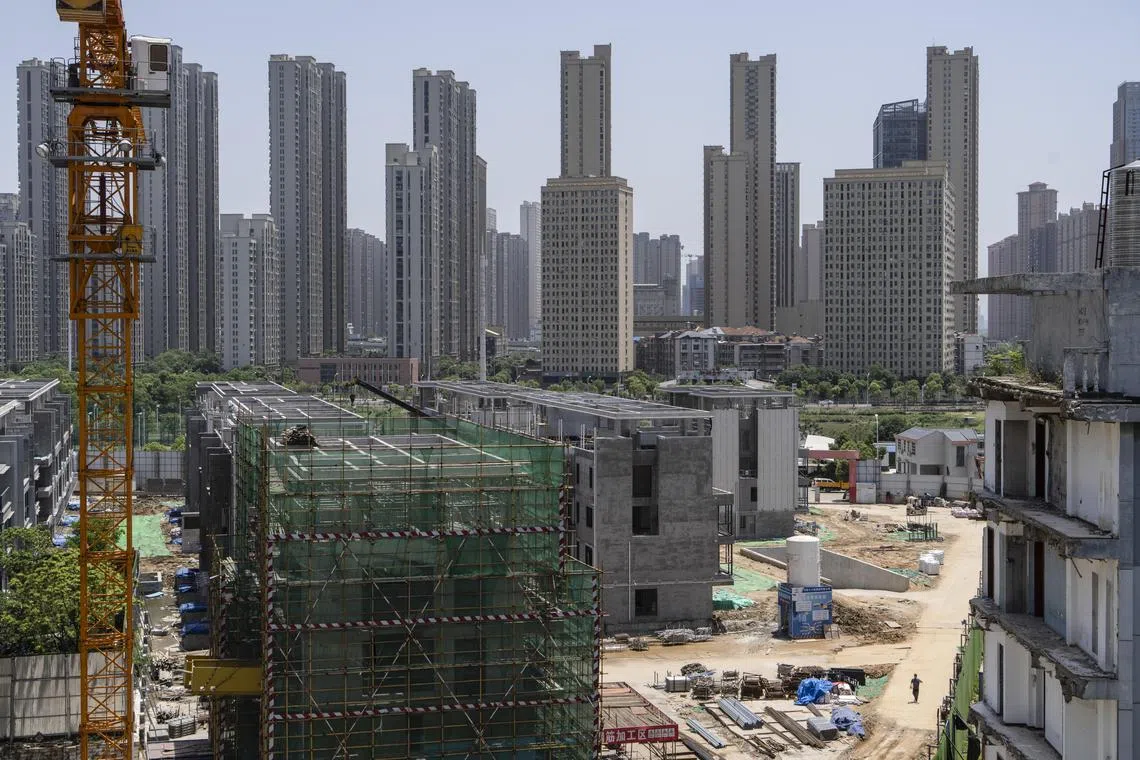China’s unworkable housing rescue maths prolonging the crisis
Sign up now: Get ST's newsletters delivered to your inbox

Purchases of unsold apartments in China stood at only 1.9 per cent nationwide as at July.
PHOTO: NYTIMES
Follow topic:
BEIJING - In May, China’s central government urged more than 200 cities to buy unsold homes to ease oversupply.
The glacial pace of implementation – driven in large part by the unattractive economics of the plan for local governments – underscores the challenge President Xi Jinping faces as he tries to arrest a record property slump that is threatening to undermine the country’s growth targets.
The plan has been a key part of the government’s attempt to shore up the real estate sector while achieving Mr Xi’s goal of creating more affordable housing. The disappointing progress raises the pressure for more forceful measures as China tries to deal with 382 million sq m of excess inventory, equivalent to the size of Detroit.
“Local governments have made slow headway,” Mr Ding Zu Yu, chairman of Shanghai CRIC Info Tech, wrote in a late August report. Purchases stood at only 1.9 per cent of unsold apartments nationwide as at July, Mr Ding estimates.
Local bureaucrats are reconciling the demands from Beijing while trying to be prudent about costs. Buying apartments at this point makes little financial sense for those officials, as apartment prices are expected to drop at least another 30 per cent in major cities before stabilising, according to Jefferies Financial Group.
Estimated returns from turning inventory into affordable housing are also below the cost of funding. Rental yields in China’s tier-1 cities averaged just 1.4 per cent in 2023, compared with the central bank’s funding rate of 1.75 per cent, according to Macquarie Group.
A few cities have proposed to resort to heavy bargaining to minimise their risks, raising doubts on whether distressed developers would be willing to sell their inventory. In southern Guangdong, Foshan city proposed to buy at no more than 50 per cent of the prices of similar projects nearby. Within the same province, Dongguan city plans to price for-sale affordable housing at around 50 per cent of new-home values in a survey, meaning buying costs would be even lower than that.
The potential for improved returns exists only if unsold homes were bought at a significant discount, said Mr Tyran Kam, senior director on Asia-Pacific corporate ratings at Fitch. But local governments might also be wary of doing this because of the “socio-political repercussions for local home owners”, he said.
The move risks further stressing local finances that are already on shaky ground. Regional governments’ ability to spur growth has been undermined by a record drop in income from land sales, with their budget spending shrinking in the first seven months. Among all 31 provinces and municipalities, only Shanghai recorded a fiscal surplus in the first half.
“We do not expect a wide roll-out of the purchase programme due to the lack of funding and the fact that banks and state-owned firms need to bear the full credit and investment risks,” said Creditsights Singapore senior credit analyst Zerlina Zeng.
Central bank programme
While state buying of housing inventory is widely seen as a key step towards easing the glut, uptake of the central bank’s funding support has also been low.
Only 12.1 billion yuan (S$2.21 billion) or 4 per cent of the People’s Bank of China’s 300 billion yuan re-lending programme had been utilised as at the end of June, public data showed.
The limited use of existing financing programmes signals that the returns and cash flow from social housing are “insufficient” to service associated debt, Fitch Ratings analysts wrote in an Aug 29 note.
Analysts have also been sceptical about whether the central bank funding is sufficient, as it is just a fraction of the one trillion yuan to five trillion yuan that is needed to fix the supply-demand mismatch.
To address funding concerns, China is considering letting local governments use special loans to purchase excess residential units, which would give them access to as much as 1.6 trillion yuan of funding, Bloomberg reported in August. That would be more than enough to fund the home-buying programme, which is expected to not exceed one trillion yuan for 2024 to 2025, according to Bloomberg Intelligence.
Relaxing rules
Stringent purchasing requirements have also added to the challenges. In May, a suburban district in Hangzhou stipulated that potential targets be completed collective sale assets with enough car parking space. Chongqing demands that building selections have a subway station, school and hospital within a kilometre.
Still, other cities with similar requests are lowering the bar. In August, the southern tech hub of Shenzhen stopped requiring that target assets be fully constructed. Zhaoqing city in southern Guangdong province ceased limiting purchases to collective sale buildings. Shangqiu city in central Henan province has dropped its location standards.
“More cities are likely to ease their rules to expand the pool of potential targets,” Mr Ding wrote.
But for now, China may struggle to sell its home bailout plan to local governments, said Bloomberg Intelligence analyst Kristy Hung. “The meagre rental yields hardly justify the risk.” BLOOMBERG

